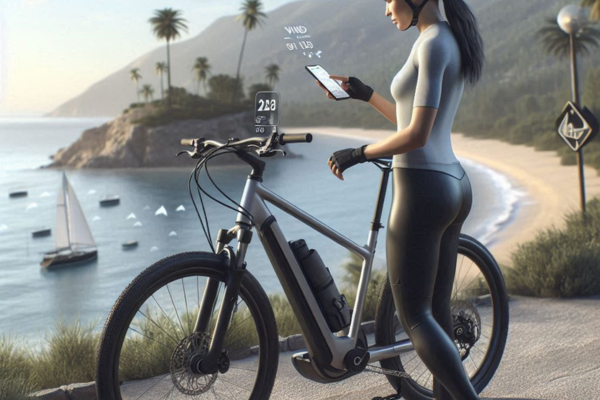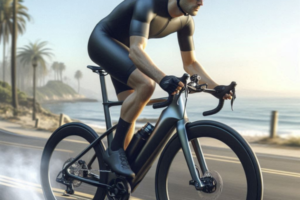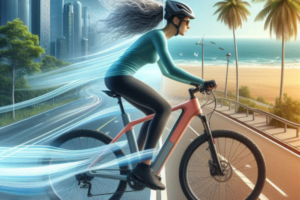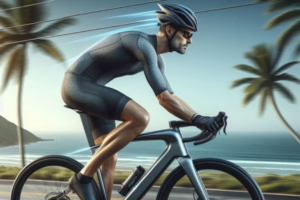🌬️ Wind Strategy 101: Planning E-Bike Routes Based on Wind Direction
Riding an e-bike along coastal routes offers breathtaking views and invigorating experiences. However, the ever-changing wind conditions in these areas can significantly impact your ride’s efficiency and comfort. Understanding and planning your routes based on wind direction isn’t just for professional cyclists; it’s a practical strategy that every e-bike rider can adopt to enhance their journey.
Wind resistance becomes a more prominent factor at higher speeds, which e-bikes often achieve with ease. A headwind can drain your battery faster, reduce your speed, and make the ride more strenuous. Conversely, a tailwind can assist your ride, allowing you to travel further with less effort. By integrating wind direction into your route planning, you can optimize your rides for energy efficiency and enjoyment.
🧭 Understanding Wind Direction
Wind direction is typically described by the direction from which it originates. For instance, a “north wind” comes from the north and blows towards the south. This information is crucial when planning your route:
- Headwind: Wind blowing directly against your direction of travel, increasing resistance.
- Tailwind: Wind blowing in the same direction as your travel, aiding your movement.
- Crosswind: Wind blowing perpendicular to your direction, which can affect balance and control.
By identifying the prevailing wind direction for the day, you can plan your route to start against the wind and return with it, making the most of your energy and battery life.
📱 Tools for Wind-Aware Route Planning
Several tools can assist in planning your e-bike routes with wind considerations:
- Windy.com: Provides real-time wind maps and forecasts, helping you visualize wind patterns along your intended route.
- AccuWeather: Offers detailed weather forecasts, including wind speed and direction, which can be crucial for daily ride planning.
- Komoot: A route planning app that allows you to customize your journey, taking into account terrain and, with some integrations, weather conditions.
Utilizing these tools can help you make informed decisions about when and where to ride, ensuring a more pleasant and efficient experience.
🕒 Timing Your Ride
Wind conditions can vary throughout the day. Typically, coastal winds intensify in the afternoon due to temperature differences between land and sea. Planning your rides during times when winds are calmer, such as early morning, can make your journey more manageable. Alternatively, if you’re seeking a more challenging ride or training session, afternoon rides against stronger winds can provide a rigorous workout.
🧠 Strategic Route Planning
When planning your route:
- Start your ride heading into the wind. This approach ensures that you tackle the more challenging part of your journey while you’re fresh and your battery is fully charged.
- Plan to return with the wind at your back, making the latter part of your ride more comfortable and conserving battery life.
- Consider loop routes that minimize exposure to crosswinds, which can affect stability, especially on e-bikes with panniers or other accessories.
By thoughtfully planning your route with wind direction in mind, you can enhance your ride’s efficiency, safety, and enjoyment.
🧭 Adapting Your Route Based on Wind Patterns
Now that you understand how wind direction influences your ride, it’s time to apply that knowledge to route planning. Whether you’re commuting through a coastal city, exploring rural paths, or navigating urban streets, adapting your e-bike route to the wind can save energy, improve comfort, and even enhance safety.
🌬️ Choose Your Direction Wisely
Wind direction can either be your ally or your biggest obstacle. To make the most of it:
- Headwind first: Begin your ride heading into the wind so that you face the toughest conditions when you’re freshest.
- Tailwind return: Finish with the wind at your back to enjoy a smoother, faster ride home—especially useful when your battery is lower.
- Crosswind caution: Avoid long stretches of unprotected sidewind exposure, particularly on bridges, coastal roads, or open fields.
A smart directional plan helps balance effort and makes the most of your bike’s capabilities.
🌎 Geographic Terrain Considerations
The terrain you ride through also interacts with wind in specific ways. Understanding how your environment affects airflow can help you choose smarter routes:
| Terrain Type | Wind Impact | Planning Tip |
|---|---|---|
| Coastal trails | Constant wind exposure | Use dunes, trees, or buildings as wind shields |
| Urban streets | Buildings redirect wind unpredictably | Plan routes with consistent street walls or alley buffers |
| Open countryside | Strong gusts with minimal shelter | Ride early in the day or on tree-lined roads |
| Bridges or ridgelines | Crosswinds can destabilize your ride | Cross at lower speeds and avoid in high-wind forecasts |
🕓 Wind Timing: Use Daily Patterns
In coastal regions, wind tends to follow predictable daily patterns. Sea breezes often strengthen in the afternoon as land heats up faster than the water. This creates a window of opportunity for early morning rides when conditions are calmer.
- Morning: Ideal for longer rides—less wind resistance and lower temperatures.
- Midday to afternoon: Expect stronger headwinds—plan your route accordingly.
- Evening: Winds may taper off again depending on location, but light conditions and temperature drops should be considered.
Riders who align their trips with natural wind cycles not only save battery but reduce physical strain and improve ride satisfaction.
🛣️ Loop Routes vs. Out-and-Back
Loop routes are ideal when managing wind direction. They allow you to divide exposure and maximize tailwind use across multiple legs. Out-and-back routes can be riskier if wind intensity increases while you’re heading home, turning a smooth outbound ride into a difficult return.
💡 Insight: Don’t just plan for distance—plan for direction. The wind may be invisible, but its impact is very real.
🚴♀️ Real Riders, Real Strategies: Applying Wind Awareness to Daily Routes
Understanding wind patterns is one thing—applying that knowledge in real-world scenarios is where the true benefit lies. Let’s look at how e-bike riders with different goals and conditions use wind strategy to make their rides smarter, smoother, and more enjoyable. These examples showcase how small planning adjustments can lead to major improvements in efficiency and ride quality.
🌊 Case 1: Marina, Coastal Commuter in a Windy Port City
Marina commutes 10 km along a coastal road every morning in a city known for its strong sea breezes. Initially, she struggled with unpredictable winds on her return home, often drained of battery and energy. After using Windy.com to track wind direction, she started planning her route to begin facing the headwind and return with a tailwind.
- 📍 Distance: 20 km round trip
- 🌬️ Wind strategy: Starts early with headwind, returns with tailwind around midday
- 🔋 Result: Battery range increased by 12%, ride time reduced by 9 minutes
This simple switch gave Marina more predictable commute times and eliminated mid-ride battery anxiety.
🏙️ Case 2: Luis, Urban Rider Navigating Street Gusts
Luis lives in a large metropolitan area and uses his e-bike daily for errands. In the afternoons, wind gusts often whip between tall buildings, causing instability. By analyzing the layout of his city blocks, he began choosing routes that offered wind-buffered corridors—using alleyways and tree-lined streets during peak wind hours.
- 📍 Distance: 5–8 km errands per day
- 🏙️ Wind strategy: Avoids wide avenues; favors tighter grid layouts during windy periods
- ⚖️ Result: Less wobble, improved control and overall comfort
By understanding how buildings redirect wind, Luis found safer, calmer routes even in chaotic urban settings.
🏞️ Case 3: Sara, Weekend Rider in Rolling Countryside
Sara enjoys long rides through open countryside every Saturday. These roads are scenic but wide open to wind. After noticing how strong tailwinds made her outbound rides feel easy—but turned her returns into a struggle—she reversed her loop route to begin facing into the wind and finish with it behind her.
- 📍 Distance: 35–50 km weekend routes
- 🌀 Wind strategy: Clockwise loop adjusted weekly based on forecast
- ⏱️ Result: More consistent pacing, 10–15% less perceived effort
She now looks forward to windy days, knowing she’s using the terrain and air to her advantage.
📦 Case 4: Tomás, E-Cargo Delivery Rider in Mixed Terrain
Tomás runs an eco-delivery service using a heavy-duty cargo e-bike. His routes change daily, and he often faces unpredictable wind across hills and bridges. He started using hourly wind forecasts and rearranged his delivery order to minimize headwind exposure on uphill sections and maximize tailwind on flat returns.
- 📍 Distance: 30–40 km per day
- 📦 Wind strategy: Prioritizes deliveries in wind-prone areas early in the day
- 🚚 Result: Fewer delivery delays, smoother load handling on slopes
By merging wind awareness with logistics, Tomás cut down delays and now finishes his routes with more energy to spare.
🧠 What These Riders Teach Us
No matter the environment or reason for riding, the wind is a factor you can’t ignore. But with a little foresight and the right tools, you can turn a challenge into a predictable, manageable variable. Riders who factor wind into their route strategy report higher satisfaction, less strain, and more consistent ride outcomes.
💡 Takeaway: The wind doesn’t have to dictate your ride. Learn it, plan with it, and you’ll always stay one pedal ahead.
✅ Route Planning Checklist: Mastering the Wind Before You Ride
To ride smarter—not harder—it’s essential to integrate wind strategy into your pre-ride planning. This doesn’t require complex software or pro-level experience. All it takes is awareness, a few accessible tools, and a checklist you can trust. Use this wind-smart planning system before every ride, especially in coastal or open-air environments where wind conditions vary rapidly.
🧾 Wind-Aware Pre-Ride Checklist
- ✔️ Check wind forecast: Use apps like Windy, AccuWeather, or The Weather Channel. Look for wind speed and direction, not just temperature.
- ✔️ Identify prevailing direction: Where is the wind coming from? Plan your outbound ride against it.
- ✔️ Match your terrain: Consider elevation, shelter (trees/buildings), and potential exposure zones (bridges, open fields).
- ✔️ Time your ride: Ride early to avoid strong afternoon gusts, especially near the coast.
- ✔️ Choose tailwind return: Make sure the final leg of your ride benefits from wind support.
- ✔️ Prepare gear accordingly: Use aerodynamic clothing and secure panniers to reduce drag.
📊 Compare Route Types Based on Wind
Here’s a breakdown of route formats and how they interact with wind exposure, to help you make informed decisions:
| Route Format | Wind Benefit | Best For |
|---|---|---|
| Out-and-back | Simple to plan; clear wind management | Short commutes or direct errands |
| Loop | Balance wind exposure across multiple angles | Training rides or varied terrain |
| Linear with drop-off | Plan fully with tailwind for single-effort travel | One-way deliveries, commuting with pickup |
🎯 Smart Rider Habits That Work With the Wind
- Use natural wind shields: Ride near tree lines, buildings, or fences to reduce exposure on headwind sections.
- Keep a flexible route mindset: Adjust based on changing forecasts, especially in coastal or hilly areas.
- Factor in your gear: Heavy cargo or panniers increase drag—adjust speed and route accordingly.
- Watch for signs: Flags, leaves, and kite activity give clues about wind strength and direction.
🧠 When to Change Plans
There’s wisdom in knowing when to adjust or delay your ride. If sustained winds are above 35–40 km/h (22–25 mph), particularly with strong gusts, consider:
- Postponing for a few hours if the forecast improves
- Rerouting to urban corridors with better shelter
- Shortening your ride or using a public transport connection if available
🧭 Final Advice: Let the Wind Work With You
Wind doesn’t have to be your opponent. With planning, awareness, and the right route, it becomes an element you can manage—or even use to your advantage. Riding with wind strategy builds confidence, saves energy, and turns every outing into a smoother journey.
💡 Tip: A well-planned route makes even the strongest breeze feel like a tailwind.
💬 Frequently Asked Questions (FAQs)
1. How can I tell if the wind will affect my e-bike route?
Use weather apps that include wind data like Windy, AccuWeather, or The Weather Channel. Look for wind direction and speed, not just temperature. If your ride includes long, open stretches or elevated roads, even moderate winds can have a noticeable effect.
2. What’s the best way to plan a loop when wind is involved?
Start by identifying the dominant wind direction. Plan your loop so that you ride into the wind first and return with the tailwind. This allows you to use more energy early on and conserve it later, especially when your battery might be lower.
3. Should I ride slower in strong wind conditions?
Yes. Slowing down slightly in headwinds improves stability and helps you conserve energy. It also prevents sudden steering corrections in gusty crosswinds, particularly when riding with cargo or panniers that catch the wind.
4. Can I use wind to extend my battery range?
Absolutely. By timing your ride to return with a tailwind, you reduce motor strain and can achieve longer distances on the same battery charge. Smart wind strategy leads to real gains in efficiency.
5. What’s the safest way to handle crosswinds?
Lean slightly into the wind and maintain a steady posture. Keep your speed moderate and avoid overcorrecting. If your route includes long bridges or cliffs, consider rerouting or riding at calmer times of day.
💖 Final Thoughts: Ride With the Wind, Not Against It
Planning your route with the wind in mind isn’t just for elite athletes or seasoned travelers—it’s a practical habit that empowers every e-bike rider. With a little awareness and preparation, wind stops being an obstacle and starts becoming part of the rhythm of your ride.
Each gust becomes something to anticipate, not fear. Each ride becomes more intentional, more efficient, and more enjoyable. You save battery, protect your energy, and increase your confidence in the saddle.
So next time you check your weather app, don’t just look at the temperature. Look at the wind—and plan your ride like the wind is your silent co-pilot.
💡 Inspiration: Great riders don’t resist the wind—they move with it, and ride further than they thought possible.
🌍 Join the Conversation: How Do You Outsmart the Wind?
We’d love to hear your story. Have you adjusted your route because of wind? Do you have a go-to strategy or favorite tool to plan smarter rides? Let’s share insights and help one another ride better—together.
Tell us in the comments:
🌬️ What’s your best tip for managing windy rides?
🧭 Do you use apps or intuition to plan your route?
🚴♀️ What’s your favorite ride that takes advantage of a tailwind?
Let’s build a thoughtful e-bike community that respects the terrain, listens to the wind, and rides with purpose every single day. 💨🚴♀️✨



